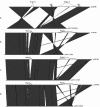Structural organization of the pFra virulence-associated plasmid of rhamnose-positive Yersinia pestis
- PMID: 15385458
- PMCID: PMC517582
- DOI: 10.1128/IAI.72.10.5613-5621.2004
Structural organization of the pFra virulence-associated plasmid of rhamnose-positive Yersinia pestis
Abstract
The 137,036-bp plasmid pG8786 from rhamnose-positive Yersinia pestis G8786 isolated from the high mountainous Caucasian plague focus in Georgia is an enlarged form of the pFra virulence-associated plasmid containing genes for synthesis of the antigen fraction 1 and phospholipase D. In addition to the completely conserved genes of the pFra backbone, pG8786 contains two large regions consisting of 4,642 and 32,617 bp, designated regions 1 and 2, respectively. Region 1 retains a larger part of Salmonella enterica serovar Typhi plasmid pHCM2 resembling the backbone of pFra replicons, while region 2 contains 25 open reading frames with high levels of similarity to the transfer genes of the F-like plasmids. Surprisingly, region 1 is also present in the pFra plasmid of avirulent Y. pestis strain 91001 isolated in Inner Mongolia, People's Republic of China. Despite the fact that some genes typically involved in conjugative transfer of the F-like replicons are missing in pG8786, we cannot exclude the possibility that pG8786 might be transmissive under certain conditions. pG8786 seems to be an ancient form of the pFra group of plasmids that were conserved due to the strict geographical isolation of rhamnose-positive Y. pestis strains in the high mountainous Caucasian plague locus.
Figures





Similar articles
-
Complete DNA sequence and detailed analysis of the Yersinia pestis KIM5 plasmid encoding murine toxin and capsular antigen.Infect Immun. 1998 Dec;66(12):5731-42. doi: 10.1128/IAI.66.12.5731-5742.1998. Infect Immun. 1998. PMID: 9826348 Free PMC article.
-
Structural organization of virulence-associated plasmids of Yersinia pestis.J Bacteriol. 1998 Oct;180(19):5192-202. doi: 10.1128/JB.180.19.5192-5202.1998. J Bacteriol. 1998. PMID: 9748454 Free PMC article.
-
[Design of a species-specific DNA probe based on the pFra plasmid of the plague pathogen].Mol Gen Mikrobiol Virusol. 1991 Oct;(10):16-9. Mol Gen Mikrobiol Virusol. 1991. PMID: 1758469 Russian.
-
Yersinia pestis pFra shows biovar-specific differences and recent common ancestry with a Salmonella enterica serovar Typhi plasmid.J Bacteriol. 2001 Apr;183(8):2586-94. doi: 10.1128/JB.183.8.2586-2594.2001. J Bacteriol. 2001. PMID: 11274119 Free PMC article.
-
Evolutionary strategies of human pathogens.Cold Spring Harb Symp Quant Biol. 2003;68:151-8. doi: 10.1101/sqb.2003.68.151. Cold Spring Harb Symp Quant Biol. 2003. PMID: 15338613 Review. No abstract available.
Cited by
-
For Someone, You Are the Whole World: Host-Specificity of Salmonella enterica.Int J Mol Sci. 2023 Sep 5;24(18):13670. doi: 10.3390/ijms241813670. Int J Mol Sci. 2023. PMID: 37761974 Free PMC article.
-
Novel plasmids and resistance phenotypes in Yersinia pestis: unique plasmid inventory of strain Java 9 mediates high levels of arsenic resistance.PLoS One. 2012;7(3):e32911. doi: 10.1371/journal.pone.0032911. Epub 2012 Mar 30. PLoS One. 2012. PMID: 22479347 Free PMC article.
-
Genome sequence of the deep-rooted Yersinia pestis strain Angola reveals new insights into the evolution and pangenome of the plague bacterium.J Bacteriol. 2010 Mar;192(6):1685-99. doi: 10.1128/JB.01518-09. Epub 2010 Jan 8. J Bacteriol. 2010. PMID: 20061468 Free PMC article.
-
A common virulence plasmid in biotype 2 Vibrio vulnificus and its dissemination aided by a conjugal plasmid.J Bacteriol. 2008 Mar;190(5):1638-48. doi: 10.1128/JB.01484-07. Epub 2007 Dec 21. J Bacteriol. 2008. PMID: 18156267 Free PMC article.
-
Genome survey and characterization of endophytic bacteria exhibiting a beneficial effect on growth and development of poplar trees.Appl Environ Microbiol. 2009 Feb;75(3):748-57. doi: 10.1128/AEM.02239-08. Epub 2008 Dec 5. Appl Environ Microbiol. 2009. PMID: 19060168 Free PMC article.
References
-
- Cornelis, G. R., and H. Wolf-Watz. 1997. The Yersinia Yop virulon: a bacterial system for subverting eukaryotic cells. Mol. Microbiol. 23:861-867. - PubMed
MeSH terms
Substances
Associated data
- Actions
LinkOut - more resources
Full Text Sources
Molecular Biology Databases

